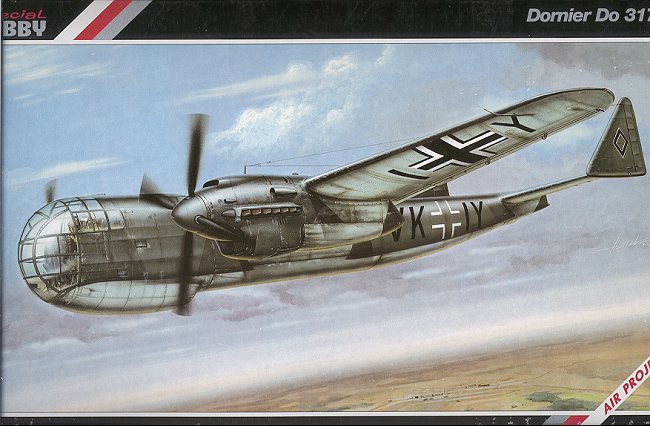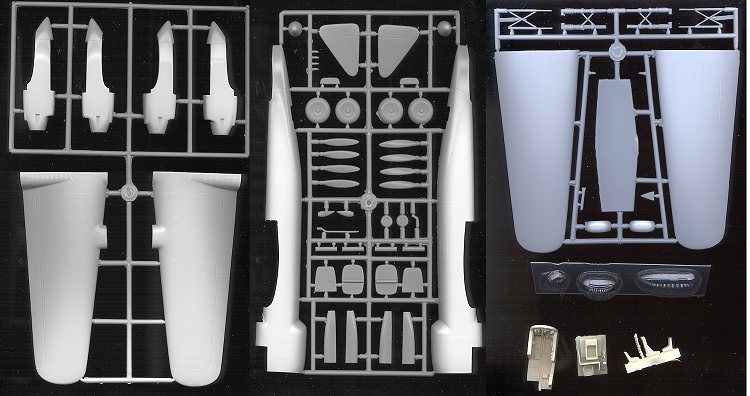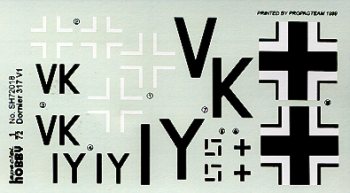
|
KIT: |
Special Hobby 1/72 Do-317v1 |
|
KIT # |
72018 |
|
PRICE: |
$24.98 |
|
DECALS: |
One aircraft, the prototype |
|
REVIEW & |
|
|
NOTES: |
Short run plastic with resin bits and vac canopy. |

|
HISTORY |
Very early in the war, the RLM issued requirements for a 'Bomber B'. This was to be an advanced medium bomber powered by a couple of 24 cylinder liquid-cooled engines then being developed. Those engines were DB 604 or Jumo 222 engines. The aircraft needed to be pressurized, have a pretty long range, carry 4,000 kg and be fast.
The two 'winners' of this contest were the Ju-288 and Fw-191, neither of which did anything more than to consume badly needed resources and take away from more important projects. The Do-317 was to be a backup in case the first two failed to reach fruition. As you can imagine, the whole Bomber B project was a fiasco for all involved and was finally terminated in mid-war, much to the relief of all involved.
The Do-317 was based on the Do-217, but was to be pressurized and powered by the DB604 engines. Once the mockup was built and approved in 1940, it was shelved while emphasis was placed on the Do217P high altitude aircraft. Revived in 1941 the prototype was powered by twin DB.603 engines and flew in 1943. It was very similar to the Do-217M other than the triangular tail surfaces. Only the one pressurized Do-317s was built. Do-317v2 thru v6 were completed as Do-217R missile carriers and saw some operational use in 1944 with III./KG40 carrying the Hs-293 wire-guided missile.
|
THE KIT |

As most of you are aware, Special Hobby is one of the number of names used for kits produced by the Czech firm of MPM. Over the years they have been continuing to improve and this is one of their more recent models. The kit is mostly injected plastic with vacuformed clear bits and resin for the interior pieces. This is a good way to get great detail for the interior with minimal fuss. Personally, I prefer most of my kits to be injected plastic as I find them so much easier to work with. Now if we can just get them to produce the clear bits in styrene I'd be very pleased.
I have a love/hate affair with short run kits. I love the subjects of many of them but seem to hate them by the time the building process has finished. This is mostly due to the generally shaky fit of many of the parts. However, one really never knows how they will fit until the kit is finished!
This one has very good engraved detailing with minimal flash and pretty small sprue gates. As with most of these kits, there are very large ejector pin marks or even stubs that will have to be removed from some of the parts, but these are quite toned down from earlier releases. As I mentioned, the cockpit is all resin with super detail. That does not extend to the wheel wells which simply have fore and aft blanking plates. The props and spinners are separate with causes some folks a bit of anxiety about getting things square during assembly.

I did notice one rather large problem with the kit. On the shorter of the three injected sprues, there is not only a great deal of flash in what should be the aileron and flap hinge line on one wing, but the entire surface of the parts feels like sandpaper. Not sure what the cause is, but you will have to do some additional preparation and hinge rescribing before construction. A closeup is shown above and you can plainly see the filled in hinge line to the right and the lumps on the left.
 Instructions are more than adequate for the job. There are 6
construction steps and the usual parts diagram. Colors are given in Humbrol
numbers though there is a conversion chart to generic color names. The exterior
paint and decal guide shows that the aircraft was painted RLM 74/75 with 76
lower color, but frankly, I would paint mine in RLM 70/71 and 65 lowers as those
would be more appropriate to a bomber than the fighter colors given. Even the
box art is in the latter colors. I have not seen more than one or two pictures
of this aircraft and they were in black and white. The decal sheet is by
Propagteam and is the same good quality of any of their sheets I have ever used.
Naturally, only the prototype is portrayed. Not surprisingly, the swastika is in
two pieces so you may wish to dive into the spares box for a replacement.
Instructions are more than adequate for the job. There are 6
construction steps and the usual parts diagram. Colors are given in Humbrol
numbers though there is a conversion chart to generic color names. The exterior
paint and decal guide shows that the aircraft was painted RLM 74/75 with 76
lower color, but frankly, I would paint mine in RLM 70/71 and 65 lowers as those
would be more appropriate to a bomber than the fighter colors given. Even the
box art is in the latter colors. I have not seen more than one or two pictures
of this aircraft and they were in black and white. The decal sheet is by
Propagteam and is the same good quality of any of their sheets I have ever used.
Naturally, only the prototype is portrayed. Not surprisingly, the swastika is in
two pieces so you may wish to dive into the spares box for a replacement.
Overall, it looks like all the short run kits from the Czech Republic are getting better and better as time goes on. With Eduard now knocking on the door of mainstream manufacturers, it won't be long before MPM and its various brands joins into the group. The kit looks to be quite buildable and with minimal additional work should be a beauty.
|
REFERENCES |
German Aircraft of the Second World War, Smith and Kay, Putnam, 1972
Review copy courtesy of me and my wallet!
If you would like your product reviewed fairly and quickly by a site that has over 1,200 visits a day, please contact me or see other details in the Note to Contributors.